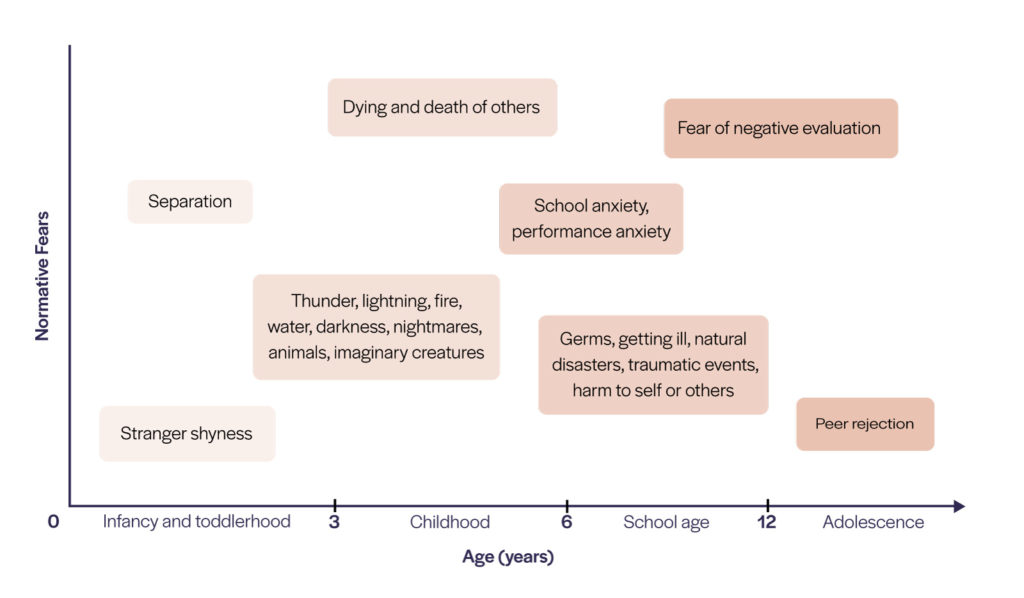Anxiety
A general resource page on anxiety in children and adolescents.
Anxiety is a normal response to a threat or to psychologic stress. Normal anxiety has its root in fear and serves an important survival function. When someone is faced with a dangerous situation, anxiety triggers the fight-or-flight response. With this response, a variety of physical changes, such as increased blood flow to the heart and muscles, provide the body with the necessary energy and strength to deal with life-threatening situations, such as running from an aggressive animal or fighting off danger. Below is a chart of normative fears that occur through childhood.
Developmentally Appropriate Anxiety

Anxiety is considered a disorder when it occurs frequently for long periods at inappropriate times and interferes with normal functioning. The causes of anxiety disorders are not fully known, but the etiology of anxiety is associated with genetic factors (including a family history of an anxiety disorder), environmental factors (such as experiencing a traumatic event or stress), and temperamental factors (child’s natural sensitivity from birth).
Screening Tools
- Screen for Child Anxiety Related Emotional Disorders (SCARED) – Child Version
- Screen for Child Anxiety Related Emotional Disorders (SCARED) – Parent Version
- GAD-7 Anxiety
When to Call CPAN
We are here to help! Please call us if you have any questions at all. Some other reasons you might call are:
- If your patient does not respond to a first line treatment
- If you would like to try a second line treatment
- If you are unsure about the diagnosis
- If your patient has more than one psychiatric disorder
- If you would like assistance in determining the level of care (for example when to consider inpatient)
- If unsure about increasing or tapering off of a medication
- If unsure about primary diagnosis
- If you need assistance discerning between psychosis and a more benign diagnosis
- If your patient can’t find a therapist
- If you would like to learn more about any topic in the field of child and adolescent psychiatry
When to refer to a child psychiatrist
- When the family situation is so complicated that treatment is being compromised
- When there are more than 2 psychiatric comorbidities
- When the diagnosis is bipolar disorder or schizophrenia
- When the first and second line treatments are ineffective
Treatment
Even though there are many different types of anxiety disorders, most anxiety disorders are simply treated with a Selective Serotonin Reuptake Inhibitor (SSRI) and/or Cognitive Behavioral Therapy (CBT). When anxiety is mild, therapy alone is recommended. If anxiety is more severe and is causing dysfunction in social or academic functioning, CBT combined with an SSRI is recommended. Efficacy is significantly increased if both CBT and an SSRI are used.
SSRIs Approved for Use in Children
| Medication | Age Range | Starting dose | Titration | Effective Dose | Max Dose |
| Sertaline | 6-12 | 12.5 mg | Increase by 25 mg after 1 week then 4-8 weeks as needed | 50-100 mg | 200 mg |
| 13 and older | 25 mg | 25-50 mg after 1 week then 4-8 weeks as needed | 50-200 mg | 200 mg | |
| Fluoxetine | 8 and older | 10 mg | 10 mg every 2 weeks then 6-8 weeks as needed | 10-40 mg | 60 mg |
| Escitalopram | 12 and older | 10 mg | 10 mg after 3 weeks | 10-20 mg | 20 mg |
Cognitive behavioral therapy (CBT)
CBT is an evidence-based treatment for reducing symptoms of anxiety. It teaches people different ways of thinking, behaving, and reacting to anxiety-producing and fearful objects and situations. One of the most important CBT techniques for children with anxiety is called exposure and response prevention. During this treatment the child is safely exposed to his/her anxiety trigger in a systematic way within a supportive therapeutic setting. The child will learn to manage that fear by facing it in structured and incremental method. As the child becomes accustomed to fears, the anxiety will reduce. Exposure and response prevention is well-researched, gentle and effective at treating anxiety disorders. Another core component of CBT is cognitive therapy, is to help the child to recognize irrational thinking and create more logical versions of those thoughts. Finally, relaxation training is helpful in targeting physical symptoms of anxiety.

